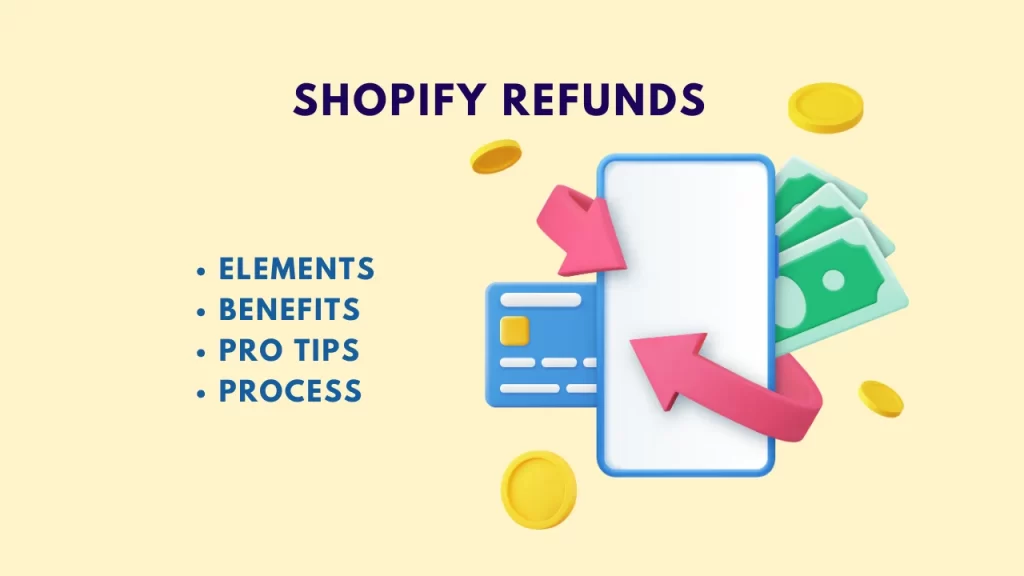Running a Shopify Store without a Shopify Refund Policy?
It is like building a Shopping Complex with no fire exit.
While this may not be impacting some Storefronts initially, however, thinking about the future of your Shopify Storefront is a must. It’s important to have a Shopify Refund Policy in place to protect both your business and your customers.
Having a structured and well-defined Shopify Refund Policy helps Shopify Businesses set a guideline to follow in situations like these.
So don’t sell on Shopify without a Shopify Refund Policy.
Here’s a definitive guide for Shopify Entrepreneurs wanting a quick crash course on how to create Shopify refund Policy for your Storefront. This article will guide you through the process of creating a Shopify refund policy that works for your store.
Shopify Refund Policy: Why Your Business Needs A Store Policy
A clear and comprehensive refund policy helps customers feel more secure when making a purchase. In 2022, e-commerce researchers found that 49% of customers would check the Store Refund Policy before making a purchase. And a detailed report from UPS.com states that sixty-six percent of the buyers checked the refund policy in 2023.
Take a glance at the latest E-Commerce Return Statistics.
- fifty-nine percent of the E-Commerce retail stores offer free return shipping
- fifty-eight percent of buyers want a ‘No Questions Asked’ return policy
- twenty-two percent of the products are returned because they look different
- fifteen percent of cart abandonment happens when the order return policy is unclear
These stats are a big reason why your business needs a Shopify refund policy.
Furthermore, having a refund policy sets expectations. It can prevent misunderstandings or disputes in the future as well.
Elements of a Shopify Refund Policy
Shopify Refund Policy is a document stating the rules and procedures for a Shopify Refund. This policy must be true and valid for any purchased product or service from the Shopify Storefront. The main purpose of the Shopify Refund Policy is to typically specify the following information.
- qualifying conditions for refunds
- the types of refunds available
- the refund duration
- the refund processes
- conditions for Shopify exchange
- conditions for Shopify partial refund
Benefits of adding a Shopify Refund Policy
Adding a refund policy to your Shopify store is important because it helps Shopify Businesses become more standardized in terms of the e-commerce industry. Here are some of the benefits of adding a Shopify Refund Policy.
- establishes trust with your customers
- demonstrates your commitment to customer service
- eliminates barriers that prevent customers from purchasing
- affects the conversion rates of an E-Commerce store.
How to Create the Best Return Policy for Shopify Storefronts

One of the first things that comes to mind when we talk about the Shopify Refund Policy is something lengthy and complex. Something that may require squinting of eyes too? Well, this is the thing with lengthy documents. The challenge is to make your Shopify Store Policy easy to follow for customers.
Here are four best practices to create the best return policy for Shopify Storefronts.
#1 Keep it clear and concise
Your refund policy should be easy to understand and straightforward. Avoid using overly complex language or legal jargon that may confuse customers. Remember that the policy is supposed to help customers and offer customer support. This will also ensure the smooth processing of refunds whenever initiated.
#2 Being transparent goes a long way
Depending upon the business, choose the best guideline and be transparent with the rules. It is best to include all relevant information about your refund policy, such as any fees or conditions that may apply. This helps customers understand what they can expect if they need to return a product.
#3 Use a free Shopify Refund Policy Template
There are plenty of Shopify refund policy templates available online that you can use as a starting point. You can also use the free Shopify refund policy template from the website and edit it as well. This can save you time and ensure that your policy includes all of the necessary information.
#4 Be consistent with the guidelines
Your refund policy should apply to all products and customers, regardless of the specific circumstances. This helps avoid confusion and ensures that all customers are treated fairly. In case there are any exceptions to the terms and conditions based on the location of the customers, mention them in the policy.
Show Commitment With A Well-Defined Store Policy
Every e-commerce return policy is created keeping the future of the business in mind.
There are times when customers want to initiate returns, or they are unsatisfied with the services or product. Your refund policy should be easy to read and understand. Using simple language and avoiding technical jargon might confuse your customers. So keep the legal language out of the door. Use clear and concise language instead.
Here are some key things to remember when crafting a well-defined Store Policy:
- Detailed terms and conditions
Be as specific as possible about the circumstances under which you’ll accept returns, issue refunds, or provide store credit. Include details about shipping, restocking fees, and any other relevant factors that might impact the refund process.
- Align with customer expectations.
Make sure that your refund policy is fair and reasonable. Consider what your customers would expect from a return policy and try to align with those expectations.
- Add a disclaimer for special cases.
While it’s important to have a clear and comprehensive refund policy in place, you should also be willing to make exceptions in certain circumstances. Consider adding a disclaimer that allows you to make judgment calls in cases where the policy might not apply.
Your refund policy is like a promise from your store.
This is where you can show off your customer service.
Consider what you can offer that other stores might not, such as free returns, no questions-asked return policy, or extended return windows. Make your return policy should be unique and distinguishable from the competitors!
Creating a Refund Policy for Your Shopify Store
Now that you understand the importance of a refund policy and the best practices to creating one, let’s move over to the process of creating your Shopify Refund Policy. To create a refund policy for your Shopify store, begin with a template.
There are a variety of Shopify refund policy templates available online that you can use as a starting point. You can also create your own from scratch if you prefer. But let’s be honest, there isn’t too much that needs to be originally created.
Step 1: Create from a template
Open your Shopify store and click on Settings in the bottom left of the screen.
Then choose Policies. This section will show you all the store policies, such as the refund policy, shipping policy, privacy policy, etc. To continue creating your Shopify refund policy, click Create from Template button in the upper left corner.
Step 2: Customize the template for your store
All you need to do is find a template and update it as per the current e-commerce standards.
Once you have a template in place, customize it to fit your specific store and products. This may include adding specific information such as:
- shipping fees
- handling fees
- restocking fees
Once done customizing, click save to finish customizing your policy.
Step 3: Steps to add the policy to your store
Once you’ve finalized your refund policy, make sure to add it to your Shopify store. Here are some steps that you have to follow to add the policy to your store.
- Navigate to “Settings”
- Go to “Legal”
- Then click on “Refund policy”
- Now copy and paste your policy into the text box.
Step 4: Add the policy to your footer menu
Consider adding the policy to the Shopify footer menu. This will make it easy for customers to find and read before making a purchase. Adding your policy to the footer menu ensures that your refund policy is easily accessible to customers. After saving the refund policy, return to the home page and click Online Theme under Navigation. Then click the Footer menu to add your refund policy.
Then click on Add Menu Item in the footer menu display. Now add the Policies and Save the menu items. Do not skip this step if you have a Shopify Refund Policy.
Step 5: Test your policy
Before you publish your refund policy, make sure to test it thoroughly to ensure that it’s clear and concise. You may also consider having a friend or family member read through it and provide feedback. Then click Customize to continue the process and select Add Block in the Footer category to design the footer menu. Then click Text to insert your article.
After this, click the link sign to add your refund policy and press Save.
How to Offer Store Credit on Shopify
In addition to offering refunds, you may also want to consider offering store credit as an alternative. Store credit can be a great option for customers who may want to return a product but still want to shop at your store.
Here’s how to offer a store credit on Shopify
Create a store credit option. Then take the following route of actions:
Navigate to “Settings” > “Payments” > “Manage” > “Create a new payment”
Conclusion
Without a refund policy in place, customers may be hesitant to make purchases from your store, particularly if they are unsure about whether they can return a product. Use your Shopify Refund Policies as a means to encourage customer action.
A Shopify Refund Policy encourages customers in the following ways:
- First-Time Customer: Helps the customer in building trust
- Customer Looking for Refund: Helps customer understand the process of refund
A lack of clear guidelines can result in misunderstandings and disputes. This can ultimately harm your business reputation. Get in touch with Shopify SEO Consultant to shape your Refund Policy and streamline your Shopify SEO.











